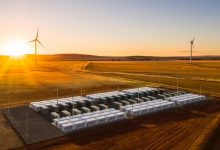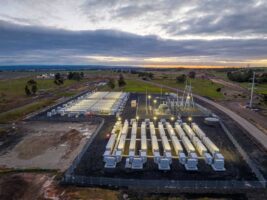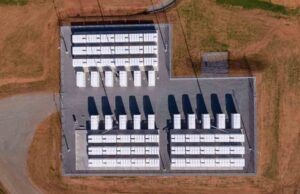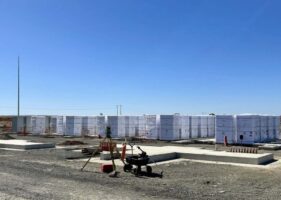The Tesla big battery in South Australia on Friday celebrates its first anniversary since swinging into action on November 30 last year – a day before its official opening.
In that period, the 100MW/129MWh Tesla big battery – officially known as the Hornsdale Power Reserve – has defied the critics and naysayers and proved that it can make money, lower prices and boost grid security. More than that, it has become a major signpost to the future of faster, cheaper, smarter and cleaner grid.
The Tesla big battery – still the world’s biggest lithium-ion battery – officially exchanged contracts on December 1, but readers will remember it was actually called into action a day earlier by the Australian Energy Market Operator anxious to help it deal with potential grid issues.
Almost immediately, it displayed is wares by stepping into the market when the big Loy Yang A generator tripped, reacting more quickly and precisely than the lumbering fossil fuel generators the grid has traditionally relied upon, so much so that AEMO has praised the battery for its speed, versatility and accuracy.
Its performance has opened up a whole new world to network operators, grid owners and project developers, and underlined the need for regulators and rule-makers to move quickly to keep up with technologies to ensure that the myriad functions of batteries can be reflected in the markets.
The Tesla big battery is now playing a key role in AEMO’smanagement of the grid and its protective systems, as illustrated when the battery stepped in to stabilise the grid when Queensland and South Australia were islanded by a major network fault caused by two lightinight strikes. Outages were suffered in every state apart from South Australia, thanks to the role of the battery.
It is also making money, and lowering costs. The battery cost $91 million, but has likely lowered costs by around $50 million, according to Neoen CEO Franck Wotiez.
“It has been an amazing project,” Wotiez told RenewEconomy this week. “It is amazing, too, for us and for AEMO. It is really positive.
“I was with premier of South Australian on Friday and we were highlighting the savings to the taxpayers, thanks to added competition to the market. I think the common number is $50 million of savings from FCAS.”
Neoen may release further analysis of its performance in coming weeks.
What is already known is most of those savings have been achieved by smashing the cartel of gas generators that was controlling prices in the FCAS market.
Neoen revealed details of the battery’s own performance when it issued detailed documents to support its recent initial public offering.
That revealed total revenues of $A13 million in the January 1 to June 30 half year, including $2 million from its South Australia contract, and another $10.8 million from its market operations, mostly from FCAS and some from market arbitrage (buying low and selling into the peaks).
Dylan McConnell, from the Climate and Energy College in Melbourne, has used OpenNEM data to crunch some numbers for RenewEconomy on the battery’s first 12 months performance, and it shows that – as we predicted after the half-year numbers came to light – the battery is likely to have delivered revenue of $24 million in its first year.
 That is made up, as this graph above shows, of $2.86 million of net revenue from energy market trading (generation revenue minus charging costs), and another $16.75 million from FCAS market. Add in the $4 million a year it gets from the South Australia government for grid security services, that takes it close enough to $24 million.
That is made up, as this graph above shows, of $2.86 million of net revenue from energy market trading (generation revenue minus charging costs), and another $16.75 million from FCAS market. Add in the $4 million a year it gets from the South Australia government for grid security services, that takes it close enough to $24 million.
 But no one is pretending they can. This graph above, published in the recent AEMO quarterly update and highlighted by McConnell, points to the influence even a relatively small battery can have.
But no one is pretending they can. This graph above, published in the recent AEMO quarterly update and highlighted by McConnell, points to the influence even a relatively small battery can have. More importantly, the success of the battery has paved the way for other installations. Another two batteries in Victoria – at the Gannawarra solar farm (Tesla) and the Ballarat network hub (Fluence) have nearly completed commissioning, and a third is soon to join at the Wattle Point wind farm in South Australia.
More importantly, the success of the battery has paved the way for other installations. Another two batteries in Victoria – at the Gannawarra solar farm (Tesla) and the Ballarat network hub (Fluence) have nearly completed commissioning, and a third is soon to join at the Wattle Point wind farm in South Australia.
Then a third wave will emerge at the Kennedy (Tesla), Lake Bonney (Tesla), Lincoln Gap (Fluence), Bulgana (Tesla) and Snowtown wind and solar projects. UK billionaire Sanjeev Gupta has big plans for an even bigger battery near Whyalla, and batteries at Newman and Alice Springs have proved their worth in supporting diesel and gas generators and slashing fuel costs.
But there’s still a lot to do. Tesla has made some money, but it has the advantage of being the first mover.
The battery and other storage may point to the way of a 100 per cent renewable energy grid, but it is now clear that regulators and rule makers need to catch up. Much of what Tesla and other batteries do and can do is not rewarded, because the market does not exist.
Archaic rules limit its ability to act on the grid, and that is why many of them still need government support to get built. Financiers won’t come to the party while the market opportunities remain opaque.
These issues – arising from the change from 30 minute settlements that favour fossil fuel generators (and more rorting), to changes in rules that allow wind and solar farms and batteries to be dispatched as a single unit, and changes in dispatch and load definitions that will allow batteries to deliver their full potential – are on their way to being addressed, although not quickly enough for some.
“We’ve clearly seen the positives of the world’s biggest battery on the market, particularly in the ancillary services market where it has reduced prices by responding quicker and with more accuracy than conventional generators which have traditionally provided this service,” Clean Energy Council CEO Kane Thornton says.
“It means the battery can respond in an instant to help stabilise the grid when needed.
“The really impressive thing about the Hornsdale Power Reserve is that there is even more value it could provide to the energy system if the current rules of the National Electricity Market were changed to support fast frequency response.
“With a genuine ancillary market for fast frequency response (less than 6 seconds), its full potential would be available to the market.”
The final word, though, should go to AEMO, whose job is to keep the lights on and plan for the changes in the grid.
“It is meeting our expectations and we look forward to further working with proponents of this new technology,” said Damien Sanford, the head of operations.
“Its speed and laser precision in response to either dispatch targets from AEMO, or in response to system events, has been encouraging.”










